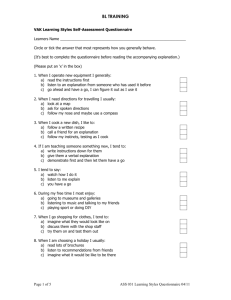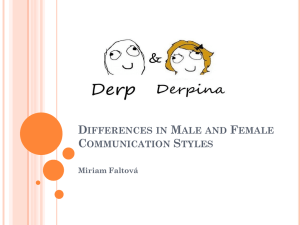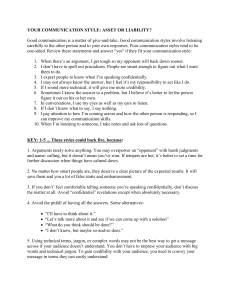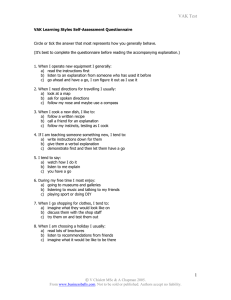VAK Learning Styles Self-Assessment Questionnaire
advertisement
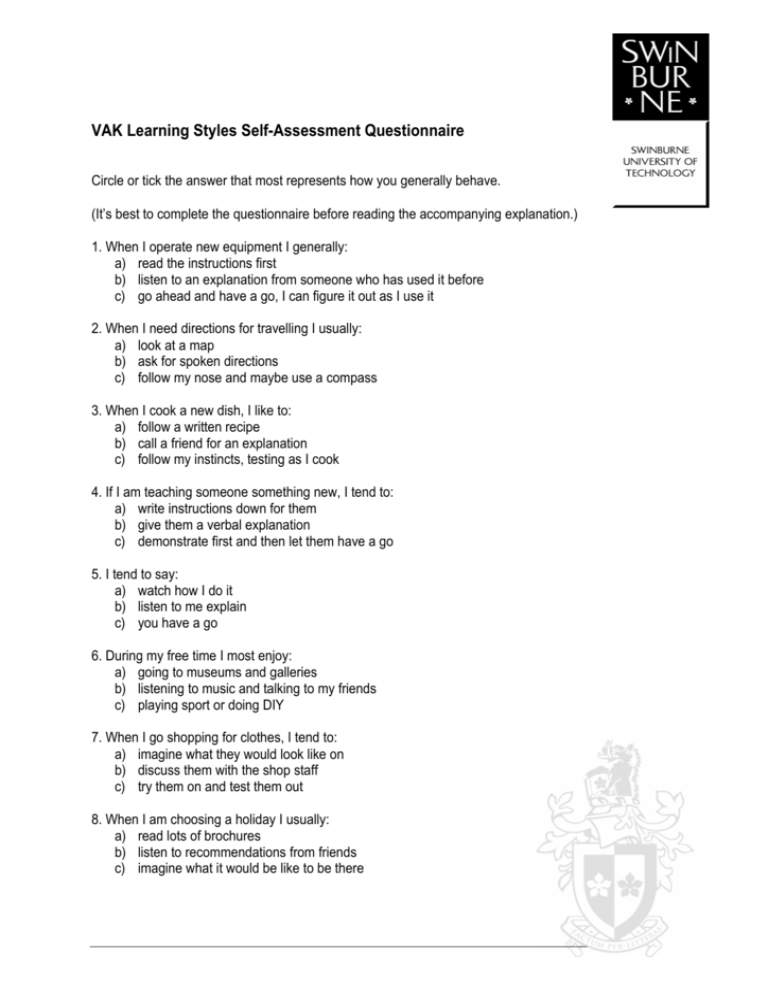
Student Services Study Skills Student Development and Counselling VAK Learning Styles Self-Assessment Questionnaire Circle or tick the answer that most represents how you generally behave. (It’s best to complete the questionnaire before reading the accompanying explanation.) 1. When I operate new equipment I generally: a) read the instructions first b) listen to an explanation from someone who has used it before c) go ahead and have a go, I can figure it out as I use it 2. When I need directions for travelling I usually: a) look at a map b) ask for spoken directions c) follow my nose and maybe use a compass 3. When I cook a new dish, I like to: a) follow a written recipe b) call a friend for an explanation c) follow my instincts, testing as I cook 4. If I am teaching someone something new, I tend to: a) write instructions down for them b) give them a verbal explanation c) demonstrate first and then let them have a go 5. I tend to say: a) watch how I do it b) listen to me explain c) you have a go 6. During my free time I most enjoy: a) going to museums and galleries b) listening to music and talking to my friends c) playing sport or doing DIY 7. When I go shopping for clothes, I tend to: a) imagine what they would look like on b) discuss them with the shop staff c) try them on and test them out 8. When I am choosing a holiday I usually: a) read lots of brochures b) listen to recommendations from friends c) imagine what it would be like to be there 9. If I was buying a new car, I would: a) read reviews in newspapers and magazines b) discuss what I need with my friends c) test-drive lots of different types 10. When I am learning a new skill, I am most comfortable: a) watching what the teacher is doing b) talking through with the teacher exactly what I’m supposed to do c) giving it a try myself and work it out as I go 11. If I am choosing food off a menu, I tend to: a) imagine what the food will look like b) talk through the options in my head or with my partner c) imagine what the food will taste like 12. When I listen to a band, I can’t help: a) watching the band members and other people in the audience b) listening to the lyrics and the beats c) moving in time with the music 13. When I concentrate, I most often: a) focus on the words or the pictures in front of me b) discuss the problem and the possible solutions in my head c) move around a lot, fiddle with pens and pencils and touch things 14. I choose household furnishings because I like: a) their colours and how they look b) the descriptions the sales-people give me c) their textures and what it feels like to touch them 15. My first memory is of: a) looking at something b) being spoken to c) doing something 16. When I am anxious, I: a) visualise the worst-case scenarios b) talk over in my head what worries me most c) can’t sit still, fiddle and move around constantly 17. I feel especially connected to other people because of: a) how they look b) what they say to me c) how they make me feel 18. When I have to revise for an exam, I generally: a) write lots of revision notes and diagrams b) talk over my notes, alone or with other people c) imagine making the movement or creating the formula 19. If I am explaining to someone I tend to: a) show them what I mean b) explain to them in different ways until they understand c) encourage them to try and talk them through my idea as they do it 20. I really love: a) watching films, photography, looking at art or people watching b) listening to music, the radio or talking to friends c) taking part in sporting activities, eating fine foods and wines or dancing 21. Most of my free time is spent: a) watching television b) talking to friends c) doing physical activity or making things 22. When I first contact a new person, I usually: a) arrange a face to face meeting b) talk to them on the telephone c) try to get together whilst doing something else, such as an activity or a meal 23. I first notice how people: a) look and dress b) sound and speak c) stand and move 24. If I am angry, I tend to: a) keep replaying in my mind what it is that has upset me b) raise my voice and tell people how I feel c) stamp about, slam doors and physically demonstrate my anger 25. I find it easiest to remember: a) faces b) names c) things I have done 26. I think that you can tell if someone is lying if: a) they avoid looking at you b) their voices changes c) they give me funny vibes 27. When I meet an old friend: a) I say “it’s great to see you!” b) I say “it’s great to hear from you!” c) I give them a hug or a handshake 28. I remember things best by: a) writing notes or keeping printed details b) saying them aloud or repeating words and key points in my head c) doing and practising the activity or imagining it being done 29. If I have to complain about faulty goods, I am most comfortable: a) writing a letter b) complaining over the phone c) taking the item back to the store or posting it to head office 30. I tend to say: a) I see what you mean b) I hear what you are saying c) I know how you feel Now add up how many A’s, B’s and C’s you selected. A’s = B’s = C’s = If you chose mostly A’s you have a VISUAL learning style. If you chose mostly B’s you have an AUDITORY learning style. If you chose mostly C’s you have a KINAESTHETIC learning style. Some people find that their learning style may be a blend of two or three styles, in this case read about the styles that apply to you in the explanation below. When you have identified your learning style(s), read the learning styles explanations and consider how this might help you to identify learning and development that best meets your preference(s). Now see the VAK Learning Styles Explanation. VAK Learning Styles Explanation The VAK learning styles model suggests that most people can be divided into one of three preferred styles of learning. These three styles are as follows, (and there is no right or wrong learning style): Someone with a Visual learning style has a preference for seen or observed things, including pictures, diagrams, demonstrations, displays, handouts, films, flip-chart, etc. These people will use phrases such as ‘show me’, ‘let’s have a look at that’ and will be best able to perform a new task after reading the instructions or watching someone else do it first. These are the people who will work from lists and written directions and instructions. Someone with an Auditory learning style has a preference for the transfer of information through listening: to the spoken word, of self or others, of sounds and noises. These people will use phrases such as ‘tell me’, ‘let’s talk it over’ and will be best able to perform a new task after listening to instructions from an expert. These are the people who are happy being given spoken instructions over the telephone, and can remember all the words to songs that they hear! Someone with a Kinaesthetic learning style has a preference for physical experience - touching, feeling, holding, doing, practical hands-on experiences. These people will use phrases such as ‘let me try’, ‘how do you feel?’ and will be best able to perform a new task by going ahead and trying it out, learning as they go. These are the people who like to experiment, hands-on, and never look at the instructions first! People commonly have a main preferred learning style, but this will be part of a blend of all three. Some people have a very strong preference; other people have a more even mixture of two or less commonly, three styles. When you know your preferred learning style(s) you understand the type of learning that best suits you. This enables you to choose the types of learning that work best for you. There is no right or wrong learning style. The point is that there are types of learning that are right for your own preferred learning style. Please note that this is not a scientifically validated testing instrument – it is a free assessment tool designed to give a broad indication of preferred learning style(s). More information about learning styles, personality, and personal development is at www.businessballs.com. With acknowledgements to Victoria Chislett for developing this assessment. Visual Learners If you have a strong preference for Visual (V) learning, you should use some or all of the following: INTAKE [To take in the information, use] underlining different colors highlighters symbols flow charts, charts, graphs pictures, videos, posters slides different spatial arrangements on the page white space textbooks with diagrams, pictures lecturers who use gestures and picturesque language SWOT [Study without tears] To make a learnable package Convert your lecture 'notes' into a learnable package by reducing them (3: 1). into page pictures. Use all techniques above to do this Reconstruct the images in different ways - try different spatial arrangements Redraw your pages from memory Replace words with symbols or initials. Look at your pages OUTPUT [To perform well in the examination] Recall the 'pictures' of pages Draw - use diagrams where appropriate Write exam answers Practice turning your visuals back into words You are holistic rather than reductionist in your approach. You want the whole picture. Visual learners do not like handouts, words, lectures, textbooks or assessment that hinge on word usage, syntax and grammar. Aural Learners A If you have a strong preference for learning by Aural methods (A = hearing) you should use some or all of the following: INTAKE [To take in the information] attend lectures attend tutorials discuss topics with other students discuss topics with your lecturers explain new ideas to other people use a tape recorder remember the interesting examples, stories, jokes.. describe the overheads, pictures and other visuals to somebody who was not there leave spaces in your lecture notes for later recall and 'filling' SWOT [Study without tears] To make a learnable package Convert your lecture notes into a 'learnable package by reducing them (3:1) expand your notes by talking with others and collecting notes from the textbook. Put your summarized notes onto tapes and listen to them. Ask others to 'hear' your understanding of a topic. Read your summarized notes aloud. Explain your notes to another 'aural' person. OUTPUT [To perform well in the examination] Talk with the examiner Listen to your voices and write them down Spend time in quiet places recalling the ideas Practice writing answers to old exam questions Speak your answers You prefer to have all of this page explained to you. The written words are not as valuable as those you hear. You will probably go and tell somebody about this. Kinesthetic Learners K If you have a strong preference for Kinesthetics (doing) learning you should use some or all of the following: INTAKE [To take in the information, use] all your senses - sight, touch, taste, smell, hearing . . laboratories, field trips , field tours examples of principles , lecturers who give real-life examples applications, hands-on approaches (computing) trial and error collections of rock types, plants, shells, grasses.. exhibits, samples, photographs.. recipes--solutions to problems previous exam papers SWOT [Study without tears] To make a learnable package Convert your lecture notes into a learnable package by reducing them (3:1) Your lecture notes may be poor because the topics were not 'concrete' or 'relevant'. You will remember the 'real' things that happened Put plenty of examples into your summary. Use case studies and applications to help with principles and abstract concepts Talk about your notes with another 'K' person Use pictures, photographs which illustrate an idea Go back to the laboratory or your lab manual Recall the experiments, field trip OUTPUT [To perform well in the examination] Write practice answers, paragraphs Role play the exam situation in your own room You want to experience the exam so that you can understand it. The ideas on this page are only valuable if they sound practical, real and relevant to you. You need to do things to understand. Adapted from http://www.vark-learn.com/english/page.asp?p=helpsheets


